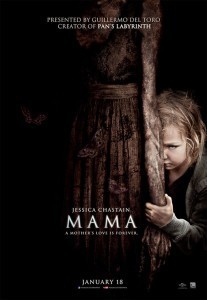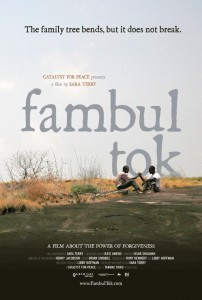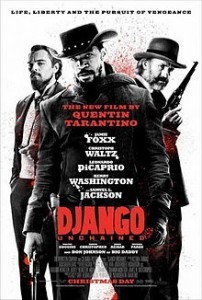Maurice Broaddus's Blog, page 30
January 27, 2013
Mama – A Review
With Pacific Rim looming in the summer distance, anything with the name Guillermo del Toro (Pan’s Labyrinth, Hellboy) attached to it catches one’s attention. Mama is a feature-length expansion of a three-minute short that director Andy Muschietti made with his sister, Barbara. Mama is one of those movies designed to make people yell at the screen. Every horror convention gets pulled out the bag of tricks with plenty of plot hinging on “just cause” moments (as in “why did he do that?” Just cause). Yet despite the premise, all of the bad horror movie tricks, and the endless stream of clichés, Mama manages to wring an effective movie. For that we can probably thank its director, some truly creepy imagery, the occasional clever twist by the screen writers, and an impressive cast.
The story opens with a dad in full family annihilator mode, Lucas (Nikolaj Coster-Waldau, Game of Thrones) on a killing spree, taking out his business partners and his estranged wife. He takes his two daughters out in the woods (setting the pattern for “just cause” plot points in this movie, where they promptly get lost. He prepares to kill them in the old spooky cabin he stumbles across when something takes them.
“I do believe there’s a place for human remains and it’s not on a shelf.”
When the girls are found, a custody battle on two fronts ensues. On the physical front, Lucas’ brother Jeffrey (also played by Coster-Waldau) and his selfish punk rocker girlfriend, Annabel (Jessica Chastain), pitted against his sister, Jean (Jane Moffat). The couple is awarded temporary custody, under the proviso that Dr. Dreyfuss (Daniel Kash) is allowed to study the girls. To expedite this process, the family is given a creepy old house to live in that they keep for these occasions (because 1) every hospital has a “in case we find feral girls out in the woods” halfway house and 2) let’s face it, there’s not a lot of “run through the house” capability in a one bedroom apartment).
“A ghost is an emotion bent out of shape.”
 On the spiritual front, we have the battle of two moms. In Annabel, we have the woman who had no intentions of ever playing mom attempting to bond with the girls and develop maternal instincts. While she is trying to establish trust, communication, and stability, we have ghost mom, Mama (7-foot-tall Spanish actor, Javier Botet) interfering in that relationship. Mama, who wants to be a mom so bad she was ready to kill to do it, presents a most disturbing spectral image. Hunched over, disjointed, a mask of pain and rage, despite her early reveal, her skeletal, spidery movements provide half of the creepy atmosphere of the movie.
On the spiritual front, we have the battle of two moms. In Annabel, we have the woman who had no intentions of ever playing mom attempting to bond with the girls and develop maternal instincts. While she is trying to establish trust, communication, and stability, we have ghost mom, Mama (7-foot-tall Spanish actor, Javier Botet) interfering in that relationship. Mama, who wants to be a mom so bad she was ready to kill to do it, presents a most disturbing spectral image. Hunched over, disjointed, a mask of pain and rage, despite her early reveal, her skeletal, spidery movements provide half of the creepy atmosphere of the movie.
The other half is provided by the girls. When they are first discovered, Victoria (Megan Charpentier) and Lilly (Isabelle Nelisse), can barely speak and aren’t socialized. While Victoria slowly begins to open herself up to the possibility of human contact and love, Lilly is having no part of it. But that’s the beauty of Lilly’s hypnotically horrific performance. She maintains her child-like innocence in the face of the reality of the horror she’s embracing. The whole movie could have just been us watching Lilly the whole time and it would succeed in creeping out the audience.
We’re all looking for a home where we could feel safe, a place of belonging and rest. We spend much of our time trying to stave off the travails of the human soul, the loneliness and sorrow; fill a hole, desire, and thirst only God could satisfy. God has made His home, a place for us to return to, a place He calls us to. The thing is, we have to be able to negotiate the difference between true love, that place to call home, and its counterfeit, the jealous, possessive thing that demands us for its own reasons. Love fights for you, the way a parent fights for their children. And love heals through the very power of presence.
The script could have used one more draft to eliminate the “what was the point of that?” moments, such as the fact that Lucas might as well have stayed in his coma since he served no purpose other than to set up the custody battle and the death by “just cause” that occurs to many characters.
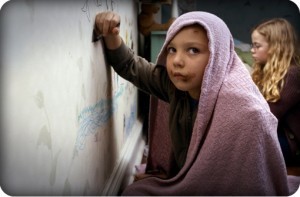 Mama plays in familiar del Toro territory, that intersection of pain and dark fantasy and examining how children deal with trauma. The weakness of it is its reliance on cheap “boo moments” (the entire community needs to have their buildings re-wired and their batteries checked). It simply doesn’t have to. In fact, the boo moments actually distract and break the mood the movie attempts to sustain by taking us out of the believability. That may sound strange when talking about a movie about ghost moms suffering for extreme post partum depression. For any horror movie to work, there has to be a buy in by the audience. With Mama, the buy in comes pretty easily as you have a ghost who can’t let go. The moments designed solely to make you jump out of your seat basically point to the story and says “we got you!” Thus pulling us out of the movie, because we DO feel got. Stripped of those things, you would actually have a stronger movie.
Mama plays in familiar del Toro territory, that intersection of pain and dark fantasy and examining how children deal with trauma. The weakness of it is its reliance on cheap “boo moments” (the entire community needs to have their buildings re-wired and their batteries checked). It simply doesn’t have to. In fact, the boo moments actually distract and break the mood the movie attempts to sustain by taking us out of the believability. That may sound strange when talking about a movie about ghost moms suffering for extreme post partum depression. For any horror movie to work, there has to be a buy in by the audience. With Mama, the buy in comes pretty easily as you have a ghost who can’t let go. The moments designed solely to make you jump out of your seat basically point to the story and says “we got you!” Thus pulling us out of the movie, because we DO feel got. Stripped of those things, you would actually have a stronger movie.
January 9, 2013
In case you missed the Apex Publications newsletter…

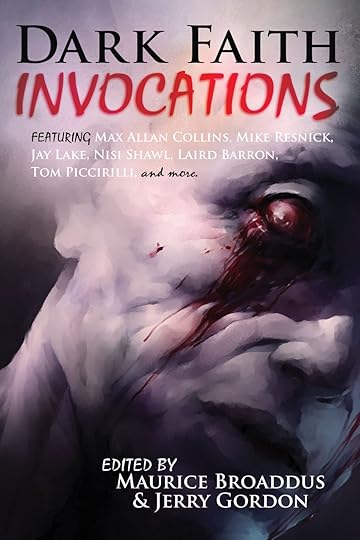 Dark Faith: Invocations
Dark Faith: InvocationsDEVOTIONALS
Apex has a lot going on with our faith-based anthology Dark Faith: Invocations, both on our blog and on Goodreads!
Back in 2009 after we released the first Dark Faith anthology, we ran a series of ‘devotionals’ by the anthology’s authors. These were highly popular and entertaining, so we’ve decided to do a second series for the second anthology. They’re scheduled to run through March (three a week… there are a lot of stories, ya know?) Monday-Wednesday-Friday. We began on Sunday with Katerina Stoykova-Klemer. Today we posted Jay Lake’s devotional.
Links:
Read Katerina Stoykova-Klemer’s devotional
Read Jay Lake’s devotional
To follow ALL the devotionals, bookmark this link:
http://www.apexbookcompany.com/tag/dark-faith-devotional/
GOODREADS READ-A-LONG
Concurrently, Lesley Conner is hosting a Read-a-Long event on Goodreads for Dark Faith: Invocations. On Monday-Wednesday-Friday, she will lead a discussion on a different story from the anthology (starting at the top of the table of contents and working her way down). On Monday, the group discussed “Subletting God’s Head” by Tom Piccirilli. Today the group is discussing “The Cancer Catechism” by Jay Lake. Come by and join the discussion. The anthology editors have been stopping by. Expect many of the authors to jump in and talk about their stories. It’s a great way to interact with some fantastic writers and other smart-minded readers.
Go here to join the Apex Publications Goodreads group and partcipate in the Dark Faith: Invocations Read-A-Long!
Of course, reading the stories enhances both the devotionals and the read-a-long. The great news is that the book is available in print and digital formats at affordable prices!
BUY DARK FAITH: INVOCATIONS!
January 8, 2013
All My Babies’ Mamas … do what now?
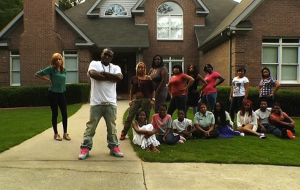 So Oxygen had an hour to kill in the spring and decided All My Babies’ Mamas was “daring” (gotta love press releases) enough programming to fit the bill. I was all set to write a piece about it because I was of two minds about the show. On the one hand, my heart immediately agree with the commenter Tay on Shadow and Act because, at first blush, I fear this can’t help but amount to coonery and buffoonery that only serves to make us look bad.
So Oxygen had an hour to kill in the spring and decided All My Babies’ Mamas was “daring” (gotta love press releases) enough programming to fit the bill. I was all set to write a piece about it because I was of two minds about the show. On the one hand, my heart immediately agree with the commenter Tay on Shadow and Act because, at first blush, I fear this can’t help but amount to coonery and buffoonery that only serves to make us look bad.
Okay, well, that actually is where I still stand.
However, when I ran across this article which has given me pause to reflect a moment, especially this quote:
Stop owning the idea of black dysfunction. Stop repeating that “we” act this or that way. Stop believing that every ill-advised or socially unacceptable act of an individual black person (or 20 black people or 1,000) is a blight on the whole of the black community or YOU personally. Stop pretending that all black behavior is endorsed by the black collective. That racist America thinks this way is no endorsement. But taking to comments sections to proclaim loudly your disgrace at how other black people are living is an endorsement of credit-to-your-race type thinking as well as the idea that the caricatures the media treat us to really are representative of our race.
Stop it with the black shame.
As I black artist, this is the tension I am constantly caught in: representing well for the community and being true to my craft. Not to say that you can’t do both, but there is this “weight”, a pressure, to do right by the community, real or imagined. Sometimes, it can’t help but mess with my head and make me second guess my characters or stories. That may be a blog for another day.
For now, I’m glad we got rid of cable because this is exactly the kind of reality show train wreck my wife insists on watching.
January 2, 2013
Fambul Tok – A Review
“The family tree bends, but it does not break.” –Sierra Leonean proverb
Whereas Django Unchained is a revenge fantasy in response to human tragedy, Fambul Tok is a documentary examining the repercussions of a more recent horror. Sara Terry brings her journalism experience in her directorial debut, slowing laying out a story of what it looks like to do the work of forgiveness.
From 1991 – 2002, civil war engulfed Sierra Leone. With a legacy of hate and colonialism that no amount of reparations can make right nor bring healing, this was a country already beleaguered by poverty, government corruption, and an ill distribution of wealth (the reality of blood/conflict diamonds had the spotlight shown on them in the eponymous movie). Three factions ripped the country apart, and in their wake: women were systematically raped, children were forced into war, villages were decimated (one person noted that in their village, even their dogs were killed), many people had forced amputations, and thousands were killed and over two million people were displaced.
Thirteen people were indicted and held responsible for the war (over $200M spent on trials for ten of them). Everyone else associated with the violence and atrocities were given blanket amnesty. So ex-combatants, empowered with amnesty, returned to their native villages to live alongside the very people they abused. This doesn’t include those people who were viewed as collaborators. And everyone had to pretend that they were fine when the reality was that seeing their abuser triggering old wounds, bumping into old hurts and setting of an emotional cascade. The abuser themselves may be wallowing in their own brokenness, not forgiving themselves or being able to find reconciliation with their own people.
A Truth and Reconciliation Committee met from 2002-2004 modeled on the South African one convened post-apartheid, but that was a western process. Few people were willing to testify, after all, they had amnesty. After that, the conventional mindset was “it’s over. Let it go.” John Caulker, a community organizer, pushed for grassroots reconciliation, to deal with the deep wounds facing his community with the hopes that people would find healing through a series of ceremonies based truth-telling and forgiveness called Fambul Tok.
 Fambul Tok, is Creole for “family talk.” Their culture wasn’t steeped in individualism, but one of community. Every member of the community felt the responsibility to make sure a child grew up properly. This is a culture built around conversation, with story-telling in the evening to talk about the day’s events. So it was an extension of this ritual of storytelling that had people confronting their abusers within the power of a story circle, telling their stories and being heard.
Fambul Tok, is Creole for “family talk.” Their culture wasn’t steeped in individualism, but one of community. Every member of the community felt the responsibility to make sure a child grew up properly. This is a culture built around conversation, with story-telling in the evening to talk about the day’s events. So it was an extension of this ritual of storytelling that had people confronting their abusers within the power of a story circle, telling their stories and being heard.
“Forgiving is being able to forgive, to forget when someone does wrong to you and to look for the future.” –Sahr
War tore apart their communities and broken relationships were the highest cost, creating stumbling blocks for moving forward. However, war didn’t destroy the culture of forgiveness. Vengeance/justice is easy, but the idea of prisons was a foreign concept to them pre-colonialism. A proverb went that “there is no bad bush where we can thrown a bad child”, so it was incumbent on the village to help transform any offender in to a resource to help rebuild the community they helped destroy.
While no one can force reconciliation, the problem with blanket amnesty was that it was a waving of a magic wand, letting everyone off the hook without cost. No one had to deal with their own issues much less the issues of those they had hurt. No one had to say “I wronged you” and essentially it was forgiveness for nothing as the forgiven didn’t even have to demonstrate remorse. The entire film is an examination of what it means to forgive. They do so for the sake of the community, for the chance to move forward.
“Any step we take moving towards light, coming back to who you were before…being part of the community is not going to be easy.” –John Caulker
Terry follows Caulker as he goes from village to village convincing the people to engage in these healing conversations. In the opening sequence, a woman told of how she was raped by 15 men, one of whom was her uncle. After she told her story, she brought him in front of the group. He told his story, then asked for her forgiveness. And she forgave him. They held hands, sang, and danced as a part of the ceremony. This isn’t a case of holding hands and singing kumbayah around a campfire, but doing the real work of forgiveness and reconciliation.
The process began with confession in the presence of the community. Such public confession was not about naming and shaming, but bringing sin to light so that everyone knew. As such, they had to create a sacred and safe space for this to take place. Even for those confessing, as they carry the guilt and shame, living in the darkness of their deeds, feeling ever marginalized, as if all fingers pointed at them.
Confession, forgiveness, and reconciliation were only the beginning. Reconciliation is the restoration to right relationship, but that doesn’t mean that trust was instantly restored, that memories were easily forgotten, and that guilt had been washed away. But it was an initial step allowing them to be able to come together. From there they could spend time with one another and bridges had the opportunity to be (re-)built.
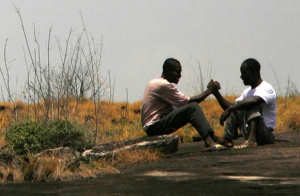 Not everyone forgives. Some want to do to their abusers what was done to them. Some people freely admit that they can’t live alongside some of the men who perpetrated crimes against their village. Stories are inconvenient reminders of past wrongs. If, in the hearing, something nags at your conscience, forgiveness and reconciliation haven’t been achieved. It takes time to work through it thoroughly. Haven’t specifically forgiven because the heart remembers the details which is why the story telling, the sharing of those details of hurt (and the abuser hearing those details) is so important. They can share specifically how they were hurt, how it impacted them, and the hearer knows what they are specifically forgiven for. Some relationships or abuse situations may never find resolution fully.
Not everyone forgives. Some want to do to their abusers what was done to them. Some people freely admit that they can’t live alongside some of the men who perpetrated crimes against their village. Stories are inconvenient reminders of past wrongs. If, in the hearing, something nags at your conscience, forgiveness and reconciliation haven’t been achieved. It takes time to work through it thoroughly. Haven’t specifically forgiven because the heart remembers the details which is why the story telling, the sharing of those details of hurt (and the abuser hearing those details) is so important. They can share specifically how they were hurt, how it impacted them, and the hearer knows what they are specifically forgiven for. Some relationships or abuse situations may never find resolution fully.
It is said that not forgiving is like drinking poison and waiting for the other person to die. Forgiveness is letting go of the poison, releasing them from the control they had over how you live. Fifty five story circle bonfires had been conducted, with over 600 people testifying before over 20,000 of their neighbors, at a cost of $1M dollars.
Fambul Tok is a hard movie to watch. It wasn’t filmed in dramatic fashion. There are no exaggerated blood effects. Just story after story of atrocity and having to witness the pain of the telling and the hearing, but to be heard and known is the point. To everything there is an end and the people were looking for a way forward to be able to eat from the same bowl again. The mystery of forgiveness is profound and there is healing to be found in it.
Django Unchained – A Review
I don’t want to unduly upset or unsettle any of my white friends, but I’ve daydreamed about killing white people. After watching Roots. After thinking about the crack of the whip on the back of slaves. After reading about lynchings. After thinking about hoses being turned on us. After I tried researching my family tree and had to sift through receipts. After every time I’ve heard the word nigger. Do not delude yourself into thinking that the pain isn’t more fresh that you’d like to believe no matter how post-racial the age you think we’re in. This is why Quentin Tarantino’s Django Unchained, while every bit a spaghetti western, feels like an empowerment vehicle, capturing a zeitgeist people are too blind to acknowledge.
After Kill Bill and Inglourious Basterds, it would be easy to see Django Unchained as their love child, yet another chapter in Tarantino’s revenge fantasy series. Like with Basterds, he is walking that line of writing an entertaining romp against the backdrop of genocide level human tragedy as too much lingering on the brutality of the time and the film could end up feeling exploitative. Considering the state of race relations in this country, especially in the wake of a contentious presidential election, this is made doubly problematic. His brand of pastiche, borrowing whole-handedly from westerns like Sergio Leone’s archetypal Man with No Name (as portrayed, for example, by Clint Eastwood in A Fistful of Dollars, For a Few Dollars More, and The Good, the Bad, and the Ugly) might not seem the best way to delve into this territory. On the flip side, I don’t recall anyone getting mad than none of the Eastwood trilogy comments on slavery.
“The way the slave trade deals in human lives for cash, bounty hunters deal with corpses.” – Dr. King Schultz (Christoph Waltz)
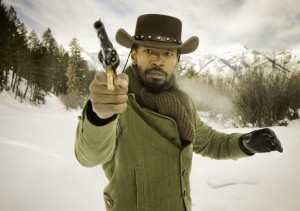 There is still the lingering specter of deriving entertainment, much less outright laughs, against the backdrop of slavery. There is a scene involving the Ku Klux Klan that recalls a Mel Brooks movie and the N-word is dropped some 109 times, in many instances to laughs (with Samuel L. Jackson as a live action Uncle Ruckus named Steppin, I mean, Stephen). Despite the voyeuristic horror of the brutality, Django Unchained is a long way from a movie like, say, Mandingo. Django Unchained consistently uses a person’s racism against them, including reducing bigots to buffoons in the aforementioned KKK scene. Like with Inglourious Basterds, the last 20 minutes of the movie is completely a bloodbath of revisionist comeuppance (the movie, in fact, being a very long countdown to it).
There is still the lingering specter of deriving entertainment, much less outright laughs, against the backdrop of slavery. There is a scene involving the Ku Klux Klan that recalls a Mel Brooks movie and the N-word is dropped some 109 times, in many instances to laughs (with Samuel L. Jackson as a live action Uncle Ruckus named Steppin, I mean, Stephen). Despite the voyeuristic horror of the brutality, Django Unchained is a long way from a movie like, say, Mandingo. Django Unchained consistently uses a person’s racism against them, including reducing bigots to buffoons in the aforementioned KKK scene. Like with Inglourious Basterds, the last 20 minutes of the movie is completely a bloodbath of revisionist comeuppance (the movie, in fact, being a very long countdown to it).
Slavery is an inconvenient horror for many because it punctures the central conceit of the American Dream in that the freedom promised was built, literally, on the backs of slaves. In Django Unchained, Tarantino uses blaxploitation era movies and remixes them through Corbucci and Peckinpah to create a wonderfully entertaining revenge fantasy. And the movie should be taken simply as that. It can’t truly comment or wrestle to the totality of the horror because that horror is too real and too immense to be dealt with in the movie that was constructed. Vengeance is easy to grasp and derive a vicarious (and very human) thrill response to. It’s ultimately not real, but it’s easy and satisfying in the moment.
[Wondering what it would be like to tackle an immense human tragedy a different way, I thought I’d check out the movie, Fambul Tok.]
December 31, 2012
Writing Goals 2013
 I don’t do New Year’s resolutions, but I do like to set goals for myself to keep me productive. First, let me see what goals I set for myself last year:
I don’t do New Year’s resolutions, but I do like to set goals for myself to keep me productive. First, let me see what goals I set for myself last year:
I have two short stories in the back of my skull that need an excuse to be born. I only have three stories out there actively searching for a home. So I’m going to set my goal for six short stories.
On the novel front, I have three definite projects: Scout (my first sci-fi novel attempt), Pimp My Airship (I need to commit to doing this … and soon), and a Middle Grade detective novel (children’s books have my interest of late). Then I will return to my collaboration with Wrath James White before he crawls through teh Interwebz and chokes my procrastinating ass or figure out what I need to do with Steppin Razor.
Next is the report card. I don’t know what two short stories were percolating in the back of my head, but neither of them got written. Stories I wrote were:
-Being in Shadow (Appalachian Undead)
-Voices of the Martyrs (done on spec for a theme anthology)
-Family Dinner (Punchnel’s)
-The Invitation (not really a short story, but as the text for an illustrated children’s novel, it runs about short story length)
As for the novels:
-Scout became Nomad and is under consideration at a couple houses.
-Special Ed: The Usual Suspects is my Middle Grade novel that has been sent to my agent
-Wrath: Wrath James White received my section of our novel collaboration. Any delay is now officially on him.
But that was it. I didn’t get as far as I thought I would. I blame some of this on the freelance projects I picked up. Plus, we did get Dark Faith: Invocations put to bed. So I basically wrote half as much as I thought I would. Thinking through my 2013 goals:
-I will begin the year with Steppin’ Razor (novella), The Revolution Will Not Be Televised (my Pimp My Airship novelization), and a short story set in my steamfunk universe.
-I have four stories I “have” to write, but I’d like to get six completed.
-I will complete my half of the Wrath book.
-I have a movie script I need to get going on.
-I have two novels and two short stories to dust off, revise, and get into the publication pipeline.
I’m pretty sure that’s it, but I’m leaving myself some flexibility. I never know when a new project will pop up or if a project will demand me to revisit it. Plus, well, the day job. Hopefully some of the projects I have in the pipeline will actually see the light of day in 2013 (speaking of, the piece of art above is there for foreshadowing purposes). Here’s hoping you see a lot of me.
December 30, 2012
In Case You Missed My Blogs in 2012
 This isn’t so much of a “my best blogs of 2012” as much as here are some of my favorites for you to check out in case you missed them:
This isn’t so much of a “my best blogs of 2012” as much as here are some of my favorites for you to check out in case you missed them:
No More Broaddus Family Truth Times – okay, I admit, I should have known how this story was going to end. Ironically, I wrote the father-son post Ashtrays in spite of this …
Missing Mama Bears – My dear friend Sara Larson passed away this year.
Finding the Cool Kids Table – Is there any such thing as the “cool kids table” when it comes to being welcomed into the genre writing community?
Being Creative, Christian, and Crazy – I begin a discussion revolving around mental health issues and creatives. This has evolved into being the theme for next year’s Mo*Con.
Conflating Faith and Politics – The title says it all and I rant about my frustration with this dilemma.
Runaway Republicans – I guess this was the capper of my unintended look at the Republican Party. This began with my review of the documentary on black conservatives, Runaway Slave, ramped up with my interview with the documentary’s creator, C.L. Bryant.
Why I’m not a Christian Spec Fic Writer – I refer to myself as a (genre) writer who is a Christian, not a Christian (genre) writer for a reason.
Putting the Urban in Urban Fantasy – I always thought urban fantasy meant something entirely different…
I never seem to have time to write – well, that’s pretty self-explanatory. We have to make time to write. A corollary to that is Following the Way of Michael Jackson, where we have to learn to write through even the difficult times of life.
Slush Pile Warrior, Part Deux – I recently wrote a piece for the SFWA Bulletin on things I learned from the slush pile of Dark Faith. I figured it would be a while before I’d have anything good to share again, after all, I JUST WROTE ABOUT WHAT I DIDN’T WANT TO SEE AGAIN. Oops… Of course, it’s a great companion piece to Wooing the Slush Reader. But we can still learn from our rejections.
A few other online notables from me:
Family Dinner – a short story that was one of the winners of Punchnel’s zombie-themed short story contest.
Writing Excuses: Writing the Other – this was a great conversation with Brandon Sanderson, Mary Robinette Kowal, and Howard Tayler.
A Conversation With Author Maurice Broaddus on Speculative Fiction, the Craft of Writing, Race and Science Fiction, and C.L. Bryant – with Chauncey Devega, this is what happens when black geeks get together.
December 26, 2012
The God Engines – A Review
I don’t like to review books by friends and very rarely do it on my blog. For one thing, you never know how they’re going to take it. Even if the review overall is good, we (people in general) remember the critical comment(s) and sometimes it’s hard to divorce yourself from your work (“don’t bring your beef with me into your review” “What beef?” “Obviously you have one or you wouldn’t have said what you did”). Secondly, I personally don’t like to hurt anyone’s wallet. Many of my friends are professionals and I don’t want to cost them potential sales.
Don’t get me wrong, I really love it when I read a friend’s work and I dig it. That’s the fastest way to get me to my blog (I’m thinking of Cullen Bunn’s The Damned or The Damned: Prodigal Sons or Ekaterina Sedia’s The House of Discarded Dreams). All of which brings me to John Scalzi.
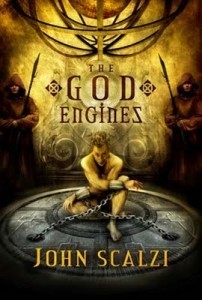 Scalzi and I have been friends for a while and have had more than a couple conversations on spiritual topics, because I love how his mind comes at things. I was looking for an excuse to read something of his when he mentioned his novella, The God Engines. He gave me a two-fold admonition: 1) “You’re free to not like this book” (I’ve since co-opted this when talking to potential new readers, because there’s nothing like relieving a friend of the burden of “having” to like their book, see “you never know how’re they’re going to take it/divorcing them from their work”); and 2) “If you don’t like it, you’ll not like it in an interesting way.”
Scalzi and I have been friends for a while and have had more than a couple conversations on spiritual topics, because I love how his mind comes at things. I was looking for an excuse to read something of his when he mentioned his novella, The God Engines. He gave me a two-fold admonition: 1) “You’re free to not like this book” (I’ve since co-opted this when talking to potential new readers, because there’s nothing like relieving a friend of the burden of “having” to like their book, see “you never know how’re they’re going to take it/divorcing them from their work”); and 2) “If you don’t like it, you’ll not like it in an interesting way.”
“For great is the Lord and greatly to be praised; He is to be feared above all gods.” –Psalms 96:4
The thing is, The God Engines may not be the best introduction to Scalzi’s work, others warned me, as it lacks his trademark humor. It is a work that starts in a bleak place, opening with the line “It was time to whip the god,” and then moves to darker places.
We’re presented with a far flung future where a space faring people, govered by the Bishopry Militant who serve their One True Lord, use (lesser) gods to guide their ships, like warp core deities. A world where faith is as real and tangible as magic and a future where the faith of a crew powers the vessels, even though the gods propel the ships through space while under duress (“It was time to whip the god”).
The captain of the good ship Righteous, Ean Tephe, is pit against the ship’s high priest, Croj Andso. It’s Croj’s job, along with his acolytes, to control their god. The problem is that the gods throughout the fleet have been harder than usual to wrangle lately. Tephe gets summoned before the Bishopry and told that there is a lack of faith among the True Lord’s followers which has emboldened the lesser gods. This is where there was a bit of a leap as to the definition of faith, because you would thing with gods manifesting themselves faith might be easier to come by. Still, there’s not faith like the white heat of a new convert, so that’s what the captain is tasked to do: convert some new followers.
“To name a god is to give it power.”
The story started off a little uneven for me. The dialogue seemed stiff as everyone spouted World-Building and Dialogue and Back Story. Once everyone settled in, the story took off, with the final third being quite the pay off. The last act basically overturned every assumption, challenged everyone, and subverted expectations in ways I don’t want to spoil.
Books, art in general, are conversations between the writer and the reader and sometimes I want to say something back.
“He says both our priest and your general would have been satisfied to make his people obey Our Lord at the point of a spear. The headman suggests that to him this means that force may be the way such obeisance is usually made.” –Ysta
There’s an interesting critique under the surface of The God Engines as it walks the delicate line between a respect for what faith can be and contempt for an “unexamined faith.” Not to mention the inherent problems of conflating church and state (or worse, church and military). Scalzi deliberately echoes the world of the Middle Ages, crusading in God’s name and the idea of “assisting” Him with His plans. Where unchecked Ecclesiastical powers controlled wealth and dictated exploration, trade, and wars. And a religious stamp of approval on our prejudices and ambitions, so unlike the times we live in now.
There are many contradictory elements to faith. First off, finding faith is a lot like falling in love, and there is an element of the irrational to both. Then there are the competing compulsions faith drives people to: fear/love, hate/justice. Faith can deepen as we looking for answers, in the wake of the Lord’s silence, and don’t find them rather than having them handed to us. But that’s too scary a place to be. Faith can wither just as quickly as we find out that we have a fair weather faith, such that when a real crisis arises, it is exposed, like conversion at the tip of a spear, as empty. Either way, you have to figure out whether your faith is worth living (or dying) for.
There is plenty a reader could be offended by in The God Engines if they are so inclined. I’m simply not so inclined, as I don’t think Scalzi set out to make a book to offend. Provoke some questions, definitely. It wouldn’t be Scalzi if the story wasn’t imbued with a deep and careful thoughtfulness. I highly dug The God Engines. Hopefully I liked it for interesting reasons, too.
December 22, 2012
End of the Year Traditions
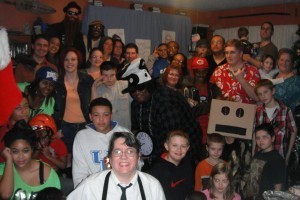 I was reminded recently about how this is the season of many of our family’s traditions. Many of them started accidentally, but they’ve accumulated over time. I knew from way back when that I wanted a few traditions or rituals that would define my family. Something me and my wife would know and would call our own, separate from our respective families. Something our kids could count on and remember when they reflect on their childhood later on.
I was reminded recently about how this is the season of many of our family’s traditions. Many of them started accidentally, but they’ve accumulated over time. I knew from way back when that I wanted a few traditions or rituals that would define my family. Something me and my wife would know and would call our own, separate from our respective families. Something our kids could count on and remember when they reflect on their childhood later on.
The way things stand now, Halloween (and the multi-day event it has become since it is my wife’s favorite holiday) is the unofficial opening to this season. But it’s with Thanksgiving that things get real. We’ve always tried to spend that day with friends, family of our choosing, either by opening our home or going to others (this year we went to a buddy’s house, deep fried two turkeys, baked a ham, and did all the fixings essentially for me, my wife, kids, and him. A glorious bacchanal of food capped off with a Magic: the Gathering marathon).
The weekend of Thanksgiving, our family makes a series of ridiculous movies (none of which shall ever hit the internet), which later serve as part of the festivities of our Broaddus family Christmas party. That started off as a murder mystery party, but as the crowd swelled each year, it evolved into a costume themed party. We then spend December scheduling time with our respective families so that come Christmas Eve and Day, we’re hanging out just as a family (though Christmas evening we open our home up again for friends who want to escape their families).
Last up is Kwanzaa. We practice it as a family, a simple evening ritual between Christmas and New Year’s Day. A quiet time as we reflect on the principles that define us as a family. This is capped by the double feast traditions. First is our New Year’s Eve party. This is an example of one of those accidental traditions, that started when my sister was pregnant: she was over one New Year’s Eve and, because she had cravings, shouted a meat she wanted me to fix a meal around. The next hour, she shouted a different meat. Next thing you know, we’d fixed a meal every hour until midnight. At which point she demanded that we do it again the following year. Second is New Year’s Day. As Kwanzaa is supposed to end with a feast, we cheat by going over to my aunt and uncle’s house as they fix a spread of food encompassing every meat group, a mix of Jamaican and American staples. We don’t even pretend that we’re going to lose weight during the last quarter of the year.*
To sum up, we’re all about remembrance. We, as a culture, have notoriously short memories and notoriously hard hearts and heads. We need rituals to draw our imaginations back to certain things, to stir our affections, and to serve as reminders to what is important in life. What are some of your traditions?
*If this sounds like a people intensive time, that’s because it is. But that’s balanced by the fact that we basically cocoon from January to March: 1) that’s how my introvert side balances out all of that extrovert activity and 2) I typically write a novel during the winter months.
December 21, 2012
Using Your Platform
 Jim Boeheim was honored by Syracuse Monday night for his 900th career victory when the third-ranked Orange defeated Detroit at the Carrier Dome. But instead of basking in his incredible achievement, the outspoken Boeheim, 68, railed against the gun culture that has turned this country into a shooting gallery for deranged serial murderers who have all-too-easy access to semi-automatic weapons.
Jim Boeheim was honored by Syracuse Monday night for his 900th career victory when the third-ranked Orange defeated Detroit at the Carrier Dome. But instead of basking in his incredible achievement, the outspoken Boeheim, 68, railed against the gun culture that has turned this country into a shooting gallery for deranged serial murderers who have all-too-easy access to semi-automatic weapons.
After the tragic shootings in Connecticut, Jim Boeheim felt compelled to speak out on America’s gun culture and used the platform afforded by his historic 900th victory to do so. In some quarters he was criticized for doing so, for politicizing this non-political moment. This comes only a few weeks after Bob Costas used his halftime report, in the wake of the Jovan Belcher murder-suicide, to also speak on the topic of gun culture and gun control.
While it’s tempting to join the chorus of debate on the topic of gun control, especially from a spiritual perspective (because guns are designed to kill people and somehow we need to reconcile our gun culture with the kingdom mindset that says “turn the other cheek” and “love your enemies), one of the other things that interests me is the use of one’s platform.
Writers are told all the time to shy away from political stands, religion, race, or anything controversial. It’s all about protecting the brand and not offending any potential readers. We’re urged to be bland to the point of inoffensiveness, as we’re driven down the path of being more worried about not losing any twitter/facebook followers. True, sometimes readers can’t differentiate your political positions from your work. More times than not, they can’t separate your douchiness from your art.
I write because I have stories to tell and something to say. I have a voice, opinions, a worldview, a perspective. I could kid us both and not post any such views on my blog, but they will and should come out in my work if I’m true to who I am. And you know what? That’s okay. What makes you unique as an artist is your voice and perspective, that special way you come at the world. Some people will like it, some people won’t. That’s okay, too.
There are some athletes who were criticized for being so bland and non-offensive, for example, Tiger Woods and Michael Jordan, because they never took a stand. They never used the platform they had to effect any real change. Maybe they ultimately weren’t about anything except their brand. There were others who risked their popularity, say Jim Brown or Muhammed Ali, chancing offending some and losing fans with each stance, but being true to who they were.
Not everyone is comfortable being a political target, I get that. I also think you’re obligated to use your or else you have squandered your gift and your opportunity, thus ultimately failing yourself and your audience.

